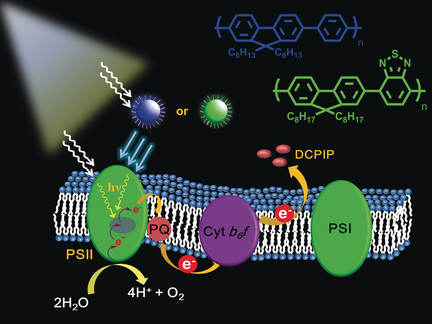Scientists advance photosynthesis using conjugated polymer nanoparticles
Solar energy is the most abundant, eco-friendly, and sustainable source. Enhancing solar energy conversion is increasingly crucial facing the crisis of global energy. Green plants can convert solar energy into chemical fuels by photosynthesis. In natural photosynthesis systems, chloroplasts containing photoreactive elements are the critical organelles. However, the absorbed light of chloroplasts is limited to visible range of the spectrum in photosynthesis process.
To improve the solar energy conversion efficiency of chloroplasts, artificial chloroplasts or chloroplast hybrid systems which transform ultraviolet light to visible light are promising.
Recently, the research group led by Prof. WANG Shu at Institute of Chemistry of Chinese Academy of Sciences (ICCAS) reported that a new bio-optical hybrid photosynthesis system with enhanced photosynthetic activity by using conjugated polymer nanoparticles (CPNs). This work was published on Angew. Chem. Int. Ed.
Two typical light-harvesting conjugated polymers with backbone structure containing fluorene units are employed to prepare CPNs. Under light irradiation, photosystem II (PS II), the critical protein complex in chloroplasts, can capture light to split water into protons, oxygen, and electrons. After reforming chloroplast with CPNs, the coated CPNs on the surface of chloroplasts can strongly absorb incident light, especially ultraviolet light, and then emit visible light that chloroplasts could absorb. Owing to the superior light-harvesting property of CPNs, PS II can capture more light transformed by CPNs to oxidize water, which generates more electrons in electron-transport chain as compared to that of natural chloroplasts. Therefore, the photosynthetic activity is enhanced by accelerated electron transport rates in photosystem II. The level of ATP production in chloroplasts is observed to be improved.
The application of light-harvesting CPNs as optical amplifier to augment photosynthesis of isolated chloroplasts was reported for the first time. This work exhibits good potential to explore new and facile nanoengineering strategy for reforming chloroplast with light-harvesting nanomaterials to enhance solar energy conversion.

photosynthesis using conjugated polymer nanoparticles (Image by Prof. WANG Shu)
Contact:
Prof. WANG Shu
Institute of Chemistry, Chinese Academy of Sciences
Email: wangshu@iccas.ac.cn





